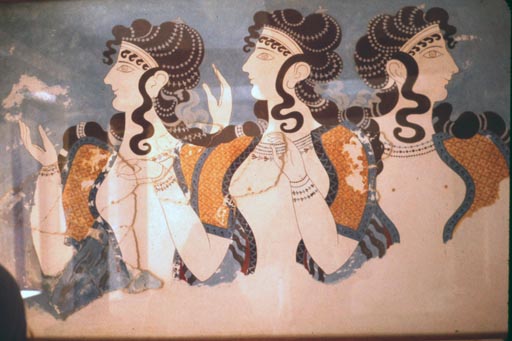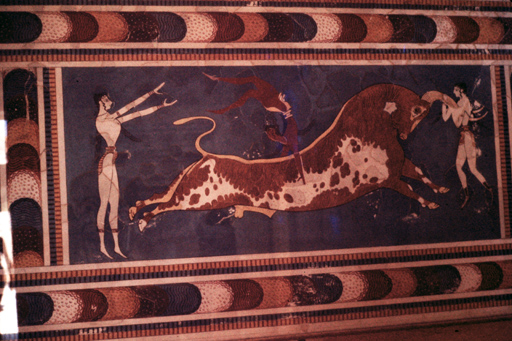Behold a 3500-year-old fresco of three Cretan ladies, found in the palace at Knossos. Except they may not be ladies, they might be goddesses. Or priestesses dressed as the goddesses they served. Or some upper-class women enjoying one another’s company. Archaeology can be complicated that way.
The principle divinity of the Cretans seems to have been female, and very likely she looked and dressed like this, with the long curling hair, the nipped-in waist, the flounced skirts, and bare breasts. I’m guessing Cretan women, even of the upper classes, didn’t dress like this all the time.
Crete followed the Egyptian pattern for depicting skin color: women were shown with white skins, while virile males had skin of reddish-brown, as in the famous fresco of the bull dancers. The male dancer is the one doing the handstand, while the other two are women.
Bull dancing seems to have been a real thing— it’s depicted in frescoes, jewelry, in metal work, and on pots. The Mycenaeans might have done the bull dance as well, or maybe just collected some of the jewelry.
They haven’t found any bull rings where the ritual might have taken place. It’s suggested that the dance took place in courtyards in the palace buildings, while the spectators sat on the wide stairways leading down into the courts. I can’t see this myself— there was nothing to protect the spectators from a rampaging bull, and the courtyards were very small to contain such action. I can see the three Cretan ladies doing ritual dances in the courts, but racing bulls and gymnasts? I don’t think so.
There were five Cretan palaces, of which four were fairly close to one another. We visited two: Phaestos and Knossos. Key features at Phaestos were built in alignment with a (presumably sacred) cave visible on Mt. Ida. The palaces’ royal quarters were unfinished when the building was abandoned
“Palace,” by the way, is probably misleading. There were places in the buildings reserved for the royal family (complete with sophisticated water and sewage systems), but most of the structures were dedicated to food storage or administration. The administrative center at Knossos was five storeys tall and covered five acres— it was really enormous, with the royals’ living space being just a small part of the whole.
None of the Cretan palaces were fortified, which argues for peaceful internal relations and a strong navy to keep out foreigners and pirates.
Weirdly enough, there were no temples or other structures devoted to the practice of religion.
The Cretan records, unfortunately, were kept in Linear A, which hasn’t been translated. No one knows what language the Minoans spoke.
I’ve read texts that speak quite confidently of a Mycenaean conquest of Crete. All palaces but Knossos were abandoned. Mycenaean pottery and other artifacts appeared, as did Mycenaean chamber tombs, and the records began to be kept in Linear B, which showed that the new ruling class and their scribes were Greek-speaking.
But there’s no evidence of conquest per se. No mass graves, no burned palaces full of dead bodies, no frescoes of fighting or war, and the Minoan culture continued alongside the Mycenaean, and survived for another six or seven hundred years. So the “conquest” may have been more like an infiltration, or the result of dynastic marriages between Cretan and mainland royal families, or maybe a palace coup by Mycenaean mercenaries.
The Iliad and other sources refer to Eteocretans, “true Cretans,” who shared the island with the Achaians (Greeks), and who were presumably the descendants of the Minoans.
When I visited Knossos, I saw a number of female visitors elaborately dressed as celebrants of some cult or other, in colorful pseudo-classical robes. From what I could hear they seemed to be taking their religion fairly seriously. The evidence for Minoan religion is attractive, evocative, and quite ambiguous, and thus lends itself to all sorts of modern interpretations and re-enactments. Snake ladies and bull dancers offer themselves as subjects for romantic speculation. (And you can ignore the human sacrifice if you want to.) I prefer to keep this stuff in the camp of fiction, and am quite happy to re-read Mary Renault rather than bang a tambourine and call upon the gods of the ancestors.
But maybe that’s just me.

